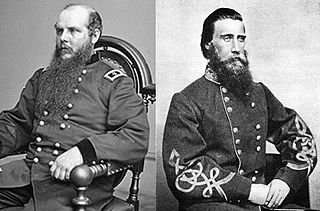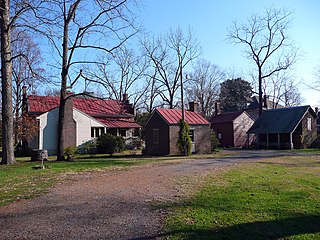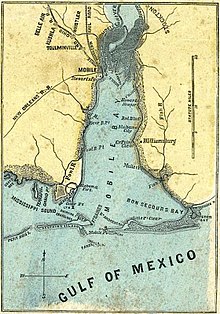
The Battle of Franklin was fought on November 30, 1864, in Franklin, Tennessee, as part of the Franklin–Nashville Campaign of the American Civil War. It was one of the worst disasters of the war for the Confederate States Army. Confederate Lieutenant General (LTG) John Bell Hood's Army of Tennessee conducted numerous frontal assaults against fortified positions occupied by the Union forces under Major General (MGEN) John Schofield and was unable to prevent Schofield from executing a planned, orderly withdrawal to Nashville.

The Battle of Nashville was a two-day battle in the Franklin-Nashville Campaign that represented the end of large-scale fighting west of the coastal states in the American Civil War. It was fought at Nashville, Tennessee, on December 15–16, 1864, between the Confederate Army of Tennessee under Lieutenant General John Bell Hood and the Union Army of the Cumberland (AoC) under Major General George H. Thomas. In one of the largest victories achieved by the Union Army during the war, Thomas attacked and routed Hood's army, largely destroying it as an effective fighting force.

The Battle of Spring Hill was fought November 29, 1864, at Spring Hill, Tennessee, as part of the Franklin-Nashville Campaign of the American Civil War. The Confederate Army of Tennessee, commanded by Lt. Gen. John Bell Hood, attacked a Union force under Maj. Gen. John M. Schofield as it retreated from Columbia through Spring Hill. Because of a series of command failures, the Confederates were unable to inflict serious damage on the Federals and could not prevent their safe passage north to Franklin during the night. The next day, Hood pursued Schofield and attacked his fortifications in the Battle of Franklin, resulting in severe Confederate casualties.

The Franklin–Nashville campaign, also known as Hood's Tennessee campaign, was a series of battles in the Western Theater, conducted from September 18 to December 27, 1864, in Alabama, Tennessee, and northwestern Georgia during the American Civil War.

The 88th Illinois Infantry Regiment was an infantry regiment from Illinois that served in the Union Army during the American Civil War. The regiment mustered into service in September 1862 and was engaged at Perryville a month later. The unit subsequently fought at Stones River, in the Tullahoma campaign, at Chickamauga, at Missionary Ridge, in the Atlanta campaign, at Franklin, and at Nashville. The 88th Illinois especially distinguished itself at Stones River, Missionary Ridge, and Franklin. The regiment mustered out of service in June 1865.

The 114th Illinois Infantry Regiment was an infantry regiment from Illinois that served in the Union Army during the American Civil War. Formed in September 1862, the regiment served in Ulysses S. Grant's Central Mississippi campaign, in the Vicksburg campaign, at Brices Cross Roads, at Tupelo, in the 1864 Missouri campaign, at Nashville, and at Spanish Fort. At Nashville, the unit participated in the decisive attack on Shy's Hill. In 1865, the regiment was reassigned as pontoniers. The regiment was mustered out in August 1865.
The 14th United States Colored Infantry Regiment was an infantry regiment that served in the Union Army during the American Civil War. The regiment was composed of African American enlisted men commanded by white officers and was authorized by the Bureau of Colored Troops which was created by the United States War Department on May 22, 1863.

The 7th Texas Infantry Regiment was a unit of Confederate States Army infantry volunteers organized in 1861 that fought mostly in the Army of Tennessee during the American Civil War. The regiment was captured at Fort Donelson in 1862 and sent to Northern prison camps. After the survivors were exchanged and new recruits added, the regiment was reconstituted and fought at Raymond, Jackson, Chickamauga, Missionary Ridge, and Ringgold Gap in 1863. The unit served in the Atlanta Campaign and at Franklin, Nashville, Averasborough, and Bentonville in 1864–1865. The regiment's 65 survivors surrendered to William Tecumseh Sherman's Federal forces on 26 April 1865.

The 10th Texas Infantry Regiment was a unit of Confederate States Army infantry volunteers organized in October 1861 that fought during the American Civil War. The regiment was captured in its first major action at Arkansas Post in January 1863. After being exchanged three months later, the 10th Texas was consolidated with two other regiments and assigned to Patrick Cleburne's division. Subsequently, the consolidated regiment fought at Chickamauga, Missionary Ridge, and Ringgold Gap in 1863. After becoming an independent regiment again, the 10th Texas fought in the Atlanta Campaign, and at Franklin and Nashville in 1864. After a second consolidation the troops fought at Averasborough and Bentonville in 1865. The regiment's soldiers surrendered to Federal forces on 26 April 1865.

The 27th Texas Cavalry Regiment, at times also known as Whitfield's Legion or 1st Texas Legion or 4th Texas Cavalry Battalion, was a unit of mounted volunteers that fought in the Confederate States Army during the American Civil War. First organized as the 4th Texas Cavalry Battalion or Whitfield's Legion, the unit served dismounted at Pea Ridge and First Corinth. Additional companies from Texas were added and the unit was upgraded to the 27th Texas Cavalry Regiment or 1st Texas Legion later in 1862. Still dismounted, the unit fought at Iuka and Second Corinth. The regiment was remounted and fought at Holly Springs in 1862, Thompson's Station in 1863, and at Yazoo City, Atlanta, Franklin, and Third Murfreesboro in 1864. The regiment surrendered to Federal forces in May 1865 and its remaining soldiers were paroled.
The 1st and 4th Missouri Infantry (Consolidated) was an infantry regiment that served in the Confederate States Army during the American Civil War. The regiment was formed on November 7, 1862 when the 1st Missouri Infantry and the 4th Missouri Infantry were consolidated as a result of heavy battle losses in both units. The regiment served in several battles in the 1863 Vicksburg campaign, including a charge that almost broke the Union line at the Battle of Champion Hill. When the Siege of Vicksburg ended with a Confederate surrender, the regiment was captured and later exchanged. In 1864, the regiment fought in the Atlanta campaign, and suffered heavy losses at the Battle of Franklin. On April 9, 1865, the regiment surrendered at the Battle of Fort Blakely, and was paroled in May when the war ended for all effective purposes.
The 2nd and 6th Missouri Infantry Regiment (Consolidated) was an infantry regiment that served in the Confederate States Army during the American Civil War. The regiment was formed on October 6, 1863, when the 2nd Missouri Infantry Regiment and the 6th Missouri Infantry Regiment were consolidated. The regiment first saw major action in the 1864 Atlanta campaign, fighting in the battles of Kennesaw Mountain and Peachtree Creek, the Siege of Atlanta, and several smaller actions. After the Confederates retreated from Atlanta, the regiment was part of a force that made an unsuccessful attack against a Union garrison during the Battle of Allatoona on October 5. The regiment then followed General John Bell Hood's Confederate Army of Tennessee into Tennessee, where it charged the Union works at the Battle of Franklin on November 30. At Franklin, the regiment suffered over 60 percent casualties, including the loss of many company commanders. After Franklin, the regiment was detached from the rest of the army to build fortifications, missing the Battle of Nashville. In March 1865, the regiment was transferred to Mobile, Alabama. On April 9, 1865, the regiment was captured at the Battle of Fort Blakely; the survivors of the regiment were paroled at Jackson, Mississippi in May after the Army of Tennessee surrendered.

40th Missouri Infantry Regiment was a infantry unit from Missouri that served in the Union Army during the latter part of the American Civil War. The regiment was organized in August and September 1864 to serve for 12 months. Beginning in November, the unit fought in the Franklin–Nashville Campaign. In March and April 1865, the regiment was part of the expedition that captured Mobile, Alabama. The soldiers were mustered out of Federal service in August 1865.
Hiram Bledsoe's Missouri Battery was an artillery battery that served in the Missouri State Guard and the Confederate States Army during the American Civil War. The battery was formed when the Missouri State Guard was formed as a pro-secession state militia unit in response to the Camp Jackson affair. As part of the Missouri State Guard, the unit was engaged in the Engagement near Carthage and the Battle of Wilson's Creek during mid-1861, before fighting at the Battle of Dry Wood Creek and the Siege of Lexington later that year when Major General Sterling Price led the Guard northwards towards the Missouri River. After the Missouri State Guard retreated into Arkansas in early 1862, Bledsoe's Battery served during the Confederate defeat at the Battle of Pea Ridge in March. The battery, as part of the Army of the West, transferred across the Mississippi River into Tennessee in April, where it left the Guard to enter Confederate service on April 21.

Battery K, 1st Illinois Light Artillery Regiment was an artillery battery from Illinois that served in the Union Army during the American Civil War. The battery was organized in January 1862 at Shawneetown and spent most of 1862–1863 on guard duty in western Kentucky. However, part of the battery participated in Grierson's Raid and the Siege of Port Hudson in 1863. The battery fought at Okolona, Tupelo, Spring Hill, and Franklin in 1864. The battery mustered out of Federal service in December 1864; new recruits and re-enlisted veterans transferred to Battery E, 1st Illinois Light Artillery Regiment.

The 24th and 25th Consolidated Texas Cavalry Regiment was a unit that originally consisted of two regiments of mounted volunteers that served in the Confederate States Army during the American Civil War. However, by the time the two regiments were consolidated, they fought as infantry. Both regiments organized as cavalry near Hempstead, Texas in April 1862 and were dismounted to fight as infantry in July 1862. The two regiments served in the same brigade and were captured at the Battle of Arkansas Post in January 1863. After being sent to Northern prison camps, the soldiers were exchanged in April 1863. Assigned to the Army of Tennessee, the two regiments were consolidated with two additional Texas cavalry regiments and in 1863 fought as infantry at Liberty Gap, Chickamauga, Missionary Ridge, and Ringgold Gap. In 1864, the other two Texas regiments were detached and the consolidated 24th and 25th fought as a separate infantry unit in the Atlanta campaign, at Franklin, and at Nashville. For the Carolinas campaign, the 24th and 25th fought at Bentonville before being reconsolidated with other Texas regiments and surrendering in April 1865.

The 12th Louisiana Infantry Regiment was a unit of volunteers recruited in Louisiana that fought in the Confederate States Army during the American Civil War. Formed in August 1861, the regiment served in the Western Theater of the American Civil War and was unique in that there were 12 companies. The regiment garrisoned Island Number Ten before being stationed at Fort Pillow. It fought at Second Corinth in 1862 and Champion Hill and Jackson in 1863. A detachment served during the Siege of Vicksburg and was captured. In 1864, the regiment fought in the Meridian, Atlanta, and Franklin–Nashville campaigns, suffering heavy losses at Peachtree Creek and Franklin. It fought at Bentonville in 1865 before surrendering with General Joseph E. Johnston.

The 4th Louisiana Infantry Regiment was a unit of volunteers recruited in Louisiana that fought in the Confederate States Army during the American Civil War. Formed in May 1861, the regiment served in the Western Theater of the American Civil War. The unit fought at Shiloh and Baton Rouge in 1862 and at Jackson in 1863. A detachment served during the Siege of Port Hudson and was captured. In 1864, the regiment fought in the Atlanta campaign where it lost heavily at Jonesborough. At Nashville in December 1864 most of the men were captured. The survivors were consolidated with several other units and fought at Spanish Fort in April 1865. The remnant surrendered in May 1865.

The 20th Louisiana Infantry Regiment was a unit of volunteers recruited in Louisiana that fought in the Confederate States Army during the American Civil War. The unit began its existence as the 6th Louisiana Battalion in September 1861. The battalion was augmented to regimental strength in January 1862 at New Orleans and served during the war in the Western Theater of the American Civil War. The regiment fought at Shiloh, Farmington, and Perryville in 1862. After being reduced in numbers, the regiment was consolidated with the 13th Louisiana Infantry Regiment and served at Stones River, Jackson, Chickamauga, and Missionary Ridge in 1863. The 13th-20th Consolidated Louisiana fought at Resaca, New Hope Church, Ezra Church, and Nashville in 1864. The consolidation with the 13th Louisiana was discontinued in February 1865 and the regiment was re-consolidated with other units. It fought its final battle at Spanish Fort one month before surrendering in May 1865.

The 13th and 20th Consolidated Louisiana Infantry Regiment was a unit of volunteers recruited in Louisiana that fought in the Confederate States Army during the American Civil War. It served only in the Western Theater. The unit was created in November 1862 by combining the veteran but diminished 13th Louisiana and 20th Louisiana Infantry Regiments to form the consolidated regiment. The regiment fought at Stones River, Jackson, Chickamauga, and Missionary Ridge in 1863. The 13th-20th Louisiana fought at Resaca, New Hope Church, Ezra Church, Jonesborough, and Nashville in 1864. The consolidation was discontinued in February 1865 and the 13th and 20th Infantry Regiments were re-consolidated with other units.



















